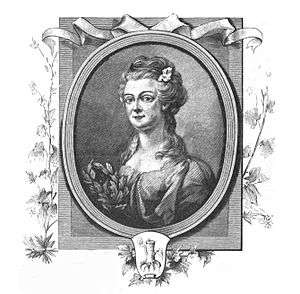Catherine Charlotte De la Gardie

Countess Catherine Charlotte De la Gardie (née Catharina Charlotta Taube; 5 April 1723 – 24 March 1763), also known as Catherine Charlotte de La Gardie, was a Swedish noble. She introduced smallpox vaccination in Sweden, and stopped the last witch trial in her country.
Life
Born to Count Edvard Didrik Taube of Odenkat and Kristina Maria Falkenberg, Catherine was the younger sister of the royal favourite Hedvig Taube. She became lady-in-waiting to Crown Princess Lovisa Ulrika in 1744, and married Count Pontus Fredrik De la Gardie, brother of scientist Eva Ekeblad, in 1748. After marriage, she settled at Sjöö Castle.
Catherine Charlotte De la Gardie are described as talented, brave, beautiful and clear sighted, without prejudices and with an open mind: she received but a shallow education meant to make her attractive on the marriage market, but she educated herself in various subjects and became a supporter of the age of enlightenment; she was a life friend of Olof von Dahlin and Carl von Linné, who expressed his admiration of her. Smallpox vaccination was officially introduced to Sweden in 1756, initially meeting with a great deal of resistance. De la Gardie had her own children vaccinated, which caused some farmers to do likewise. This is sometimes counted as the breakthrough for smallpox vaccination among the public.
The second act for which she is remembered occurred in 1758. In 1757, a witch hysteria broke out in the parish of Ål in Dalarna, where thirteen women and five men were accused of abducting children and bringing them to a witches' sabbath. The governor Pehr Ekman ordered their arrest, interrogation and torture. De la Gardie became aware of the trial during a trip to Dalarna in 1758 and, together with others, helped stop this process by making it known in the capital. The matter had been treated by the local authorities and church, and when it became known in the country, it was treated as a scandal. The parliament issued an investigation, the accused were all freed, and Governor Ekman, who had accepted charges of witchcraft and had allowed torture, was sentenced to jail and stripped of his position. De la Gardie helped the victims of the witch hunt with legal assistance and made sure they were granted compensation from the state, as the torture had made them incapable of work. For this act, she became a heroine and awarded a medal (1761), with the inscription: Catharina Charlotta Taube, comitissa De la Gardie, Fulcrum infelicibus, Ob XII ab injuria servatos cives Ordo R. Equ. 1761.
She was a friend of the poet Hedvig Charlotta Nordenflycht, whose most famous poem, Öfver en Hyacint, is a love poem which describes Nordenflycht's love for the young Johan Fischerström; her last poem is about the love triangle between Nordenflycht, Fischerström and Catherine Charlotte De la Gardie, which took place during the winter of 1762/3. De la Gardie died after having contracted a fatal disease while nursing the sick.
References
- Svenskt biografiskt handlexikon (Swedish)
- Österberg, Carin et al., Svenska kvinnor: föregångare nyskapare (Swedish women: Predecessors, pioneers). Lund: Signum 1990. (ISBN 91-87896-03-6) (Swedish)
- Anteckningar om SVENSKA QVINNOR, runeberg.org; accessed 28 January 2015. (Swedish)
- Wilhelmina Stålberg, Anteckningar om svenska qvinnor (Notes of Swedish women) (Swedish)
- Bengt Ankarloo: Satans raseri (Rage of Satan) (Swedish)
- Cathérine Charlotte De la Gardie (f. Taube), urn:sbl:17374, Svenskt biografiskt lexikon (art av B. Boéthius); hämtad 29 October 2013. (Swedish)